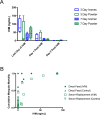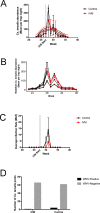Evaluation of a novel West Nile virus transmission control strategy that targets Culex tarsalis with endectocide-containing blood meals
- PMID: 30845250
- PMCID: PMC6424467
- DOI: 10.1371/journal.pntd.0007210
Evaluation of a novel West Nile virus transmission control strategy that targets Culex tarsalis with endectocide-containing blood meals
Abstract
Control of arbovirus transmission remains focused on vector control through application of insecticides directly to the environment. However, these insecticide applications are often reactive interventions that can be poorly-targeted, inadequate for localized control during outbreaks, and opposed due to environmental and toxicity concerns. In this study, we developed endectocide-treated feed as a systemic endectocide for birds to target blood feeding Culex tarsalis, the primary West Nile virus (WNV) bridge vector in the western United States, and conducted preliminary tests on the effects of deploying this feed in the field. In lab tests, ivermectin (IVM) was the most effective endectocide tested against Cx. tarsalis and WNV-infection did not influence mosquito mortality from IVM. Chickens and wild Eurasian collared doves exhibited no signs of toxicity when fed solely on bird feed treated with concentrations up to 200 mg IVM/kg of diet, and significantly more Cx. tarsalis that blood fed on these birds died (greater than 80% mortality) compared to controls (less than 25% mortality). Mosquito mortality following blood feeding correlated with IVM serum concentrations at the time of blood feeding, which dropped rapidly after the withdrawal of treated feed. Preliminary field testing over one WNV season in Fort Collins, Colorado demonstrated that nearly all birds captured around treated bird feeders had detectable levels of IVM in their blood. However, entomological data showed that WNV transmission was non-significantly reduced around treated bird feeders. With further development, deployment of ivermectin-treated bird feed might be an effective, localized WNV transmission control tool.
Conflict of interest statement
I have read the journal's policy and the authors of this manuscript have the following competing interests: BDF through the Colorado State University Research Foundation, declares a pending patent application on ideas presented within this manuscript. BC and TDA Research, Inc. have no competing interests. All other authors have no competing interests to declare.
Figures






Similar articles
-
Temperature and time of host-seeking activity impact the efficacy of chemical control interventions targeting the West Nile virus vector, Culex tarsalis.PLoS Negl Trop Dis. 2024 Aug 30;18(8):e0012460. doi: 10.1371/journal.pntd.0012460. eCollection 2024 Aug. PLoS Negl Trop Dis. 2024. PMID: 39213461 Free PMC article.
-
Predicted reduction in transmission from deployment of ivermectin-treated birdfeeders for local control of West Nile virus.Epidemics. 2023 Sep;44:100697. doi: 10.1016/j.epidem.2023.100697. Epub 2023 Jun 16. Epidemics. 2023. PMID: 37348378 Free PMC article.
-
Effects of ivermectin treatment of backyard chickens on mosquito dynamics and West Nile virus transmission.PLoS Negl Trop Dis. 2022 Mar 25;16(3):e0010260. doi: 10.1371/journal.pntd.0010260. eCollection 2022 Mar. PLoS Negl Trop Dis. 2022. PMID: 35333866 Free PMC article.
-
The contribution of Culex pipiens complex mosquitoes to transmission and persistence of West Nile virus in North America.J Am Mosq Control Assoc. 2012 Dec;28(4 Suppl):137-51. doi: 10.2987/8756-971X-28.4s.137. J Am Mosq Control Assoc. 2012. PMID: 23401954 Review.
-
Bird Species Involved in West Nile Virus Epidemiological Cycle in Southern Québec.Int J Environ Res Public Health. 2020 Jun 23;17(12):4517. doi: 10.3390/ijerph17124517. Int J Environ Res Public Health. 2020. PMID: 32585999 Free PMC article. Review.
Cited by
-
A systematic review of experimental evidence for antiviral effects of ivermectin and an in silico analysis of ivermectin's possible mode of action against SARS-CoV-2.Fundam Clin Pharmacol. 2021 Apr;35(2):260-276. doi: 10.1111/fcp.12644. Epub 2021 Jan 28. Fundam Clin Pharmacol. 2021. PMID: 33427370 Free PMC article.
-
Considerations for Human Blood-Feeding and Arthropod Exposure in Vector Biology Research: An Essential Tool for Investigations and Disease Control.Vector Borne Zoonotic Dis. 2020 Nov;20(11):807-816. doi: 10.1089/vbz.2020.2620. Epub 2020 Sep 9. Vector Borne Zoonotic Dis. 2020. PMID: 32905735 Free PMC article. Review.
-
Fluralaner treatment of chickens kills the southern house mosquito, Culex quinquefasciatus.Med Vet Entomol. 2025 Jun;39(2):385-392. doi: 10.1111/mve.12778. Epub 2024 Nov 23. Med Vet Entomol. 2025. PMID: 39579029 Free PMC article.
-
Integrating Wind Speed Into Climate-Based West Nile Virus Models: A Comparative Analysis in Two Distinct Regions.Geohealth. 2025 Jul 5;9(7):e2024GH001320. doi: 10.1029/2024GH001320. eCollection 2025 Jul. Geohealth. 2025. PMID: 40621447 Free PMC article.
-
Canine Systemic Insecticides Fluralaner and Lotilaner Induce Acute Mortality of Triatoma gerstaeckeri, North American Vector of the Chagas Disease Parasite.Am J Trop Med Hyg. 2023 Sep 25;109(5):1012-1021. doi: 10.4269/ajtmh.23-0300. Print 2023 Nov 1. Am J Trop Med Hyg. 2023. PMID: 37748769 Free PMC article.
References
-
- Reimann CA, Hayes EB, Diguiseppi C, Hoffman R, Lehman JA, Lindsey NP, et al. Epidemiology of Neuroinvasive Arboviral Disease in the United States. Am J Trop Med Hyg. 2008;76(6):974–9. - PubMed
-
- Lindsey NP, Staples JE, Lehman JA, Fischer M, Centers for Disease Control and Prevention (CDC). Surveillance for human West Nile virus disease—United States, 1999–2008. MMWR Surveill Summ. 2010. April 2;59(2):1–17. - PubMed
-
- CDC. West Nile virus disease cases and deaths reported to CDC by year and clinical presentation, 1999–2015. 2016.
-
- Fox JL. Uncertainties in Tracking West Nile Virus Undermine Vaccine Development. Microbe Mag. 2015. March 1;10(3):98–9.
Publication types
MeSH terms
Substances
Grants and funding
LinkOut - more resources
Full Text Sources
Medical
Miscellaneous

